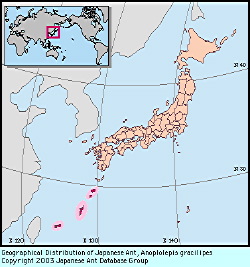
|
species
|
Anoplolepis gracilipes
|
 |
Japanese Name
|
Ashinaga-ki-ari
|
Original Reference
|
|
Smith, F. (1857). Catalogue of the hymenopterous insects collected at Sarawak, Borneo; Mount Ophir, Malacca; and at Singapore, by A.R. Wallace. Journal of the Proceedings of the Linnean Society of London, Zoology 2: 42-88.
|
Synonym
|
|
Formica longipes Jerdon (Jerdon, 1851) ,
Plagiolepis longipes (Jerdon)(Emery, 1887) ,
Anoplolepis (Anoplolepis) longipes (Jerdon) (Emery, 1925) ,
|
Description
|
|
Total length of workers around 4 mm. Body color yellow, gaster brownish (it can be greenish in some non-Japanese specimens). Antennae and legs remarkably long. Head oval. Clypeus produced medially, with convex anterior margin. Eyes relatively large and produced. Mandibles with 8 teeth. Antennae 11-segmented; scapes twice as long as the length of the head, or longer; their second to terminal segments each more than three times as long as wide. Mesosoma slender. Pronotum narrow, with almost straight dorsum in profile. Anterior portion of mesonotal dorsum, back to the propodeum, gently concave in profile. Propodeal dorsum convex in profile. Petiole thick, with an inverted-U-shaped crest. Erect hairs present on head and gaster, lacking on dorsum of mesosoma.
|
Remarks
|
|
This species is commonly found in grasslands, and at woodland margins and road sides in Okinawa Prefecture. It is also seen frequently foraging on tree trunks. Anoplolepis gracilipes (= A. longipes) might be native to tropical Africa (Wilson & Taylor, 1967) or tropical Asia (Kempf, 1972). Its distribution has clearly been expanded by human commerce, so that it is now widespread in tropical and subtropical regions of the globe. It is a well-known pest species, because it protects aphids and coccids which injure tropical crops. In this role it has been rated a secondary agricultural pest (Reimer et. al., 1990, etc.).
|
|

Distribution
|
|
Nansei Is, Volcano Is; tropical and subtropical areas, essentially worldwide; North America.
|
|
References
|
|
- A catalogue of the species of ants found in southern India. Madras Journal of Literature and Science 17: 103-127.
- Catalogo delle formiche esistenti nelle collezioni del Museo Civico di Genova. Parte terza. Formiche della regione Indo-Malese e dell'Australia. Annali del Museo Civico di Storia Naturale di Genova (2) 4 [24]: 209-258.
- Emery, C. (1925). Hymenoptera, Formicidae, Formicinae. . In M. P. Wytsman, ed., ""Genera Insectorum"", fasc. , 183, 1-302.
- Wilson, E. O. & R. W. Taylor (1967). The ants of Polynesia (Hymenoptera: Formicidae). . Pacif. Ins. Mon., 14, 1-109.
- Kempf, W.W. (1972). Catalogo abreviado das Formigas da Regiao Neotropical (Hymenoptera: Formicidae). . Studia Ent., 15, 3-344.
- Reimer, N., J. W. Beardsley & G. Jahn (1990). Pest ants in the Hawaiian Isalnds. . In R.K. Vander MeerK. Jaffe & A. Cedeno eds.Applied Myrmecology: A World Perspective. , 40-50. .
- Catalogue of the hymenopterous insects collected at Sarawak, Borneo; Mount Ophir, Malacca; and at Singapore, by A.R. Wallace. Journal of the Proceedings of the Linnean Society of London, Zoology 2: 42-88.
|
Editor
|
|
Original text by Mamoru Terayama & Masao Kubota. English translation by Mamoru Terayama, edited by Robert W. Taylor.
|
|